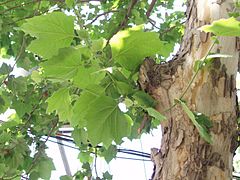Platanaceae facts for kids
Quick facts for kids Platanaceae |
|
|---|---|
 |
|
| Plantanus × hispanica | |
| Scientific classification | |
| Kingdom: | |
| Division: | |
| Class: | |
| Order: | |
| Family: |
Platanaceae
T.Lestib.
|
Platanaceae is a family of flowering plants. The family has only one genus platanus. This genus has six to ten species of tall trees. The trees grow naturally in temperate and subtropical regions of the Northern Hemisphere. In all species, the flowers grow in dense groups of small flowers. The fruits are small achenes with hairs near the base.
Description
- Large, sympodial, deciduous tree, speckled bark that sheds in large irregular sheets, leaving a smooth surface that is mottled and pale, persistent bark at the base of the trunk, indumentum with large glandular hairs, multicellular and uniserrate or short with uniserrate ramification (in candelabrum), in stellate fascicles; glandular hairs with unicellular, globular capitulum, cuticular waxes without crystalloids, with rods and plates
- Leaves generally with very variable shapes and nervation, simple, alternate, more or less distichous, isobilateral palmate with three to seven lobes (palmatifid to palmatisect) with whole edges or with glandular teeth (each one with a midvein that broadens towards the glandular apex, where it ends in an open hole), or penninerved and whole (Platanus kerrii), this shape common in young, vernal leaves in other species, vernation folded, with the petiole usually sheathed, enclosing the axillary bud (bud is free in P. kerrii), stipules foliose, large, intrapetiolar, tubular, normally caduceus, in P. kerrii scarious, small, basally fused to the petiole, domatia present, stomata irregularly anomocytic
- Stems with aggregated rays in the xylem, with nodes septilacunar, cork cambium present and superficial, buds covered by single scale
- Plants monoecious, the flowers of each sex in separate inflorescences
- Inflorescences in large hanging peduncles, each one a unisexual, globular capitulum, pedunculate or seated, with numerous flowers, derived from the condensation of a panicle, with a circular bract at the base and bracteoles among the flowers
- Flowers small, inconspicuous, hypogynous, regular unisexual, receptacle short, smooth, hypogynous disk absent, perianth reduced, sepals number three to four, rarely eight, free or basally fused, shorter than the petals, triangular. Petals number three to four, rarely eight, truncated-spatulate or vestigial, scarious, frequently absent in the female flowers, male flowers with androecium haplostemonous, isostemonous, oppositisepal, with number three to four, rarely eight, stamens, gynostemium short or vestigial, anthers basifixed, not versatile, dithecous, tetrasporangiate, elongated, connectivum apically widened, peltate, dehiscence along longitudinal valves; pistillidium sometimes present, female flowers with superior gynoecium carpels apocarpous in two or three whorls, imperfectly closed apically, surrounded by large petals, linear stylodious, stigmas internal, decurrent in two ridges, more or less dry, two ovules per carpel but one nearly always aborts, orthotropous, bitegmic, crassinucellated, pendulous, apical to marginal placentation, three or four staminodes 3-4, no nectaries
- Fruits in achene, clavate, grouped in a globular capituliform infructescence, each fruit surrounded by long hairs
- Seeds small with thin testa with little endosperm, oily and proteinaceous, embryo thin and straight with two linear cotyledons, often uneven
- Pollen in subprolate monads, 16-22 μm in length, tricolpate, sometimes sextarugate, tectate-columellate, reticulated surface, the base layer as thick as the tectum
- Chromosomal number: 2n = 14, 16, 21, 42; x probably equal to 7 or 8
Images for kids
-
49-million-year-old fossil Macginitiea gracilis from the Klondike Mountain Formation, Washington
See also
 In Spanish: Platanáceas para niños
In Spanish: Platanáceas para niños

All content from Kiddle encyclopedia articles (including the article images and facts) can be freely used under Attribution-ShareAlike license, unless stated otherwise. Cite this article:
Platanaceae Facts for Kids. Kiddle Encyclopedia.








